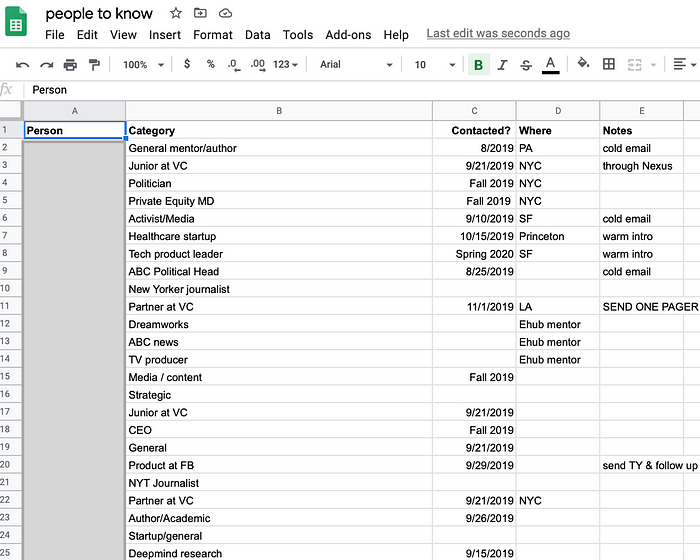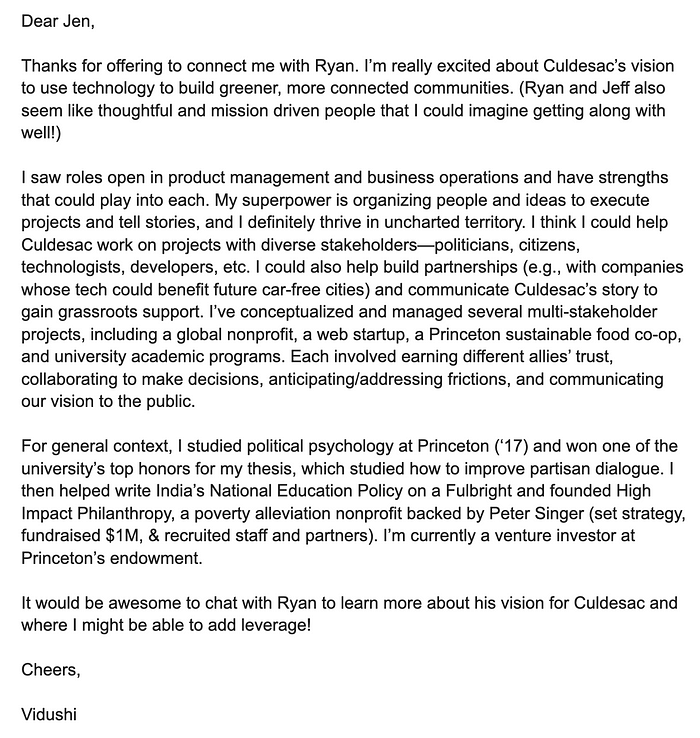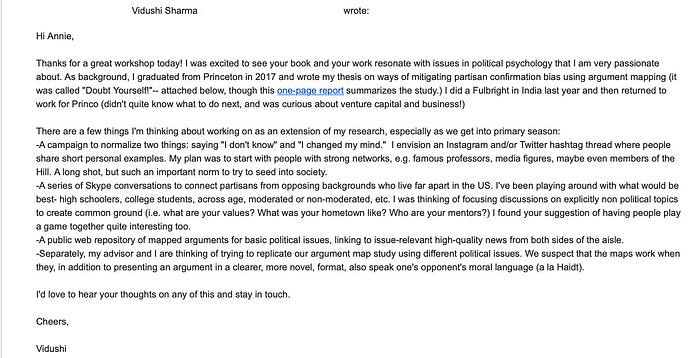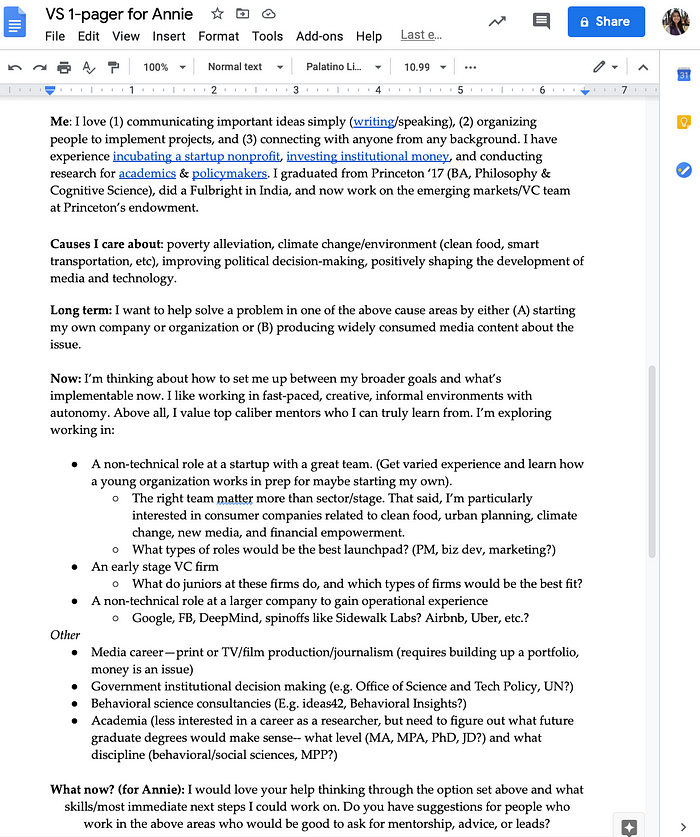
Behind-the-scenes with 50+ emails that unlocked my dream job
people, not pedigrees, were my ticket to success
If you resonate with my writing, you can sign up for my monthly-ish newsletter.
Last summer, a famous author told me that she didn’t think I would ever find a job that was a good fit. My heart sank, but I let her finish.
“You’re just going to have to create it for yourself,” she said.
That sounded romantic but hopeless. “Creating your own job” felt like an option for a Brooklyn artist with a trust fund, not an immigrant with loans.
Two years into my first job, I was feeling stuck and disillusioned, despite landing an apparently shiny investment gig after a pedigreed college experience that any parent would approve of. Tabbing through Excel spreadsheets under fluorescent lights, I wondered if I could ever be happy with my career.
A year later, though, I am working my dream job at my dream company — and I did create it for myself. This piece is part-guide, part-gratitude to reflect on what happened. Each step includes screenshots of the emails and documents I relied on along the way.
0- What career paths do you want to explore?
1- Who should you talk to?
2- How do you nail your intros?
3- How do you make your interactions worth everyone’s time?
4- What should you do once you (finally) find a product you love?
For most of my life, I didn’t connect my job search to my natural joys. I’ve always loved forming relationships between new people and ideas. I chose my college classes based purely on professor and hosted dinners where undergrad anarchists sat by campus cops. I graduated wanting to create stories that would encourage a kinder, greener world.
I assumed that the job search, however, was a tangential process that involved resume drops, coffee chats, and flattening my spirit into a LinkedIn bio. I also assumed I’d have to go through a finance, tech, or consulting job stint before designing my own career. “Earn money, make connections, and then go write your novel [or start your company, or create your TV show],” I often heard.
Most people are well-intentioned, curious, and interesting — but something about the job search process makes them iron over what makes them special.
I started to question both of these assumptions when I talked to people who were working their dream jobs, whether an ex-academic who started a Classics immersion nonprofit or a neuroscientist who tripped onto Wall Street and then became a healthcare startup CxO.
They came from various industries, but each of them had a non-linear mentality towards their careers. They skipped canned job applications and didn’t try to plan too many steps in advance. Instead, they worked on building genuine friendships with the best thinkers. Once they had inserted themselves into enough interesting conversations, serendipity emerged: relationships they formed often yielded life-changing job opportunities years later.
I realized that the most likely way I’d find or create my dream job was to get to know someone who’d trust that I was kind, smart, and cared about what they did. And that’s what happened.
Step 0: Decide what career paths to explore
To decide what career avenues to explore, I reflected on what meaningful work meant to me—some combination of what I was good at and what I valued.
This thinking happened over months—on long runs, during family dinners, and alone in my home—and still continues. I scribbled my way through books like Designing Your Life, whose exercises asked me to interrogate my view of work and life, identify my daily highs and lows, and build word maps from activities I loved. I brainstormed crazy job roles, from “start a grassroots storytelling initiative to fight ingrained interests” to “work for a company like Google on an initiative that urges people to create more.”
All this thinking and writing helped me translate what I loved into jobs I could do. Many threads I conceptualized eventually made their way into my current role at Highlighter, where I learn/distill info, act as a creator, and work in media every day.


There was no formula for how to conceptualize what meaningful work meant, but it was worth taking undistracted time to reflect on. It was the foundation of all my exploration.
Step 1: Hone in on who to talk to
As I sensed what I wanted to learn about, I started to make a list of people working in relevant areas. I scoured college alumni lists, hunted down the contact information of my favorite writers, and considered friends, family, and teachers who’d provide good perspective. I aimed big because I had nothing to lose; my questions gave me a great excuse to reach out to brilliant people. Everyone, regardless of background, has some sort of network to start with—and a world of inspiring people to reach out to online.

When I started my list, my option set was wide: I was considering getting a JD or PhD, applying for tech jobs, and even pursuing a writing/media career.
I contacted the people on my list at random to set up my first few conversations. I soon honed in on opportunities in the startup ecosystem, which felt like the most creative, flexible, and fast-paced way to use my skills to impact the causes I cared about. I focused on learning what it was like to work in big tech, venture capital, and startups at different stages.
These conversations became a flywheel as people I spoke to introduced me to others. Soon, I was taking multiple calls a day with folks hiring or willing to share advice. I joked that all I did was work, look for work, and work out. The information density was overwhelming, but it helped me narrow in on the people and roles most aligned with my interests.
It was hard to foresee the causal impact of any of these conversations in the moment. Many yielded benefits months later. As I shared my evolving thought process with them, my contacts—friends, mentors, and even interviewers—became my allies, keeping me top of mind when it came to advice, industry data, and new connections. Hearing about my exploration during a catch-up, for example, a college friend suggested I contact alum Nikhil Basu Trivedi, whose perspective as an investor was a game-changer when I was evaluating opportunities long afterwards.
Of course, some conversations resulted in immediate leaps forward, especially when they unlocked new communities to join. A year after I met Nitin Gupta (formerly at Newfront) at a friend’s wedding, I found his email on the bus coordination list and sent him a note. After an hourlong call where he shared his own reflections, he introduced me to Jen Yip, the founder of Renaissance Collective (RenCo), a community of smart generalists that completely altered my career trajectory.
Communities of curious, like-minded problem-solvers like RenCo can be a massive amplifier for anyone’s learning and network. RenCo members were kind, brilliant, and generous with their time—founders, consultants, policymakers, and creatives helped me think through my strengths, evaluate opportunities, prepare for interviews, and even pursue my creative nonfiction writing. The community was just a hop or two away from most movers and shakers in Silicon Valley. I finally felt like I had the support and the network that I needed—I just had to act on it.
Step 2: Write a killer intro, warm or cold.
Writing good intro emails was both the most labor-intensive and the most valuable part of my job search.
The warm intro: Clean intros with context made it easy for people I met to introduce me to others they knew. I aimed for emails that were concise, forwardable, and clearly stated why the connection benefitted the receiver. Here’s a clean intro I wrote for the founder of Culdesac, via Jen at RenCo.

The cold email: The magic of the Internet is that, with some effort and intention, people can reach almost anyone they want to.
Here’s an email that I wrote to Annie Duke, the author referenced at the beginning of this piece. She had come to Princeton to speak about decisionmaking, the subject of my undergraduate thesis. I referenced our area of shared passion and shared a few relevant side project ideas I had.

Here’s what she said back:

A cold email that sprouted around a shared interest ended up being one of my most valuable career mentorship opportunites. Annie introduced me to some of the most inspiring people I’ve met, like Sonal Chokshi, who urged me to create my own Substack and told me about Highlighter months before I ended up joining the team. I was an early reader of Annie’s book How to Decide, which she launched at a Highlighter town hall that I hosted over a year later.

Of course, many of the cold emails I sent went nowhere. My inbox hosts a growing list of writers, investors, and artists that I will never meet. Many never replied at all. Others replied and then dropped off. Some shot me a one liner without leaving much space for conversation. Still today, each month, I write to a few novelists and poets who have inspired my most recent personal essays, even though only a handful have ever engaged.
This exercise, however, is a practice of boldness, effort, and gratitude, with asymmetric upside. At the least, writing these messages gives me the chance to express thanks for others’ work and refine my own thinking. Occasionally, it unlocks incredible friendships and opportunities too. Just one “yes” can release a cascade of others: the few emails that have worked have changed my life.
Step 3: Set context to make your conversation worth everyone’s time
Every time I connected with someone new, I wanted to make sure I wouldn’t waste their time. The morning of my Skype call with Annie, I emailed her this one-pager for context. I laid out my background, my goals, and how she could help me.

At the end of our call, Annie offered to introduce me to several well-known people. I was concerned about placing a random ask on their time, but she told me that the 1-pager would do a great job communicating my skills and intent.
I started customizing the 1-pager for each conversation I had. This simple act in and of itself led to several interview offers. People told me the 1-pager felt more real than a resume, since it focused on framing my experience in the context of my evolving thought process. The most interesting people weren’t looking for a specific set of hard skills— instead, they wanted to hear about how my experience could be a starting point for what might come next.
I always ended calls by asking people how I could help them—and to my surprise, most folks took me up on it. I helped people recruit candidates, edit writing, read product documents, or market events. By providing them with value, I established grounds for longer-term and more collaborative relationships.
Step 4: Once you find a product you love, go deep.
Everyone has a problem that they deeply care about solving. Once I found a company or person that really struck a chord, I went deep to engage them on their top-of-mind problem. This is how, a few months ago, I created my dream job.
I first met DK, the founder of Highlighter, in February over burritos at a RenCo meetup. We kept in touch as he gave me feedback on a side project I was experimenting with.
Later that spring, I saw on Twitter that DK was running a marketing experiment called the Self-Quarantine Book Club. I loved books, so I joined the Slack group and downloaded Highlighter. Just like DK had done for me, I shared my ideas with him.


What happened next was a magical blur.
We had a three hour conversation about the origins and direction of Highlighter. I missed dinner; I scribbled pages of notes. Over the next few weeks, I worked on making ideas from my document materialize. I wrote Highlighter’s first marketing emails and brainstormed ideas for virtual book club meetings that eventually became the basis for Highlighter town halls. I went through multiple notebooks of scrawled diagrams. Our collaboration was a delight—it felt then, as it does now, like play.
By the time DK and I discussed creating a full-time position for me at Highlighter, things made perfect sense. We already knew and trusted each other: we spoke almost daily and I’d been on the team Figma, Github, and Slack for weeks. Friends and mentors I had made over the last few months helped me further vet the opportunity. Instead of going through a job interview process, I had helped someone understand who I was. And Annie’s prediction had come true.
In closing, if I think about what made this all work, it’s this: be bold, and be thoughtful. Never hesitate to pursue a connection with someone who strikes a chord once you’ve done the pre-work (consider areas of shared passion, write something up, and offer ways to collaborate). And once you’re around the right people, stay curious, leave room for serendipity, and trust the process.
The time I spent chasing down smart, inspiring people and sending lots of emails benefitted me more than scrolling through LinkedIn or going to generic networking meetups. I met people who turned into close mentors and thought partners, and I created my own dream job. There is no way to predict where those relationships will lead, but I am thankful for them every day.
“You can’t connect the dots looking forward; you can only connect them looking backwards. So you have to trust that the dots will somehow connect in your future…This approach has never let me down, and it has made all the difference in my life.” — Steve Jobs
Some helpful resources:
- Community: Renaissance Collective: a community of smart generalists who help each other navigate careers in tech. I cannot recommend this group of allies highly enough. RenCo has been a game changer for me.
- Self-reflection: Designing Your Life, The Art of Possibility, 80,000 Hours Career Guide
- Starting point for candidate sets of companies: onejob, 80,000 Hours (impact oriented), Golden Gate recruits, Role Call, Breakout Startup List, VC talent networks (e.g. First Round, smaller venture firms like Teamworthy, etc).
I’m happy to talk more— just DM me on Twitter at @m1shti or send a note to mishti@highlighter.com. You can find more of my writing on Substack.
A career takes a collective, and a reflection like this does, too. Much gratitude to David King, Annie Duke, Nikhil Basu Trivedi, Bailey Richardson, Sahil Lavingia, Ishan Dikshit, Samvitha Ram, Nitin Gupta, Drew DiPrinzio, Corrie Kavanaugh, Max Mailman, Anju Sharma, Rajat Bhu, and my RenCo friends—Jen Yip, Stanley Chen, Alizeh Iqbal, Jeff Diament, & Charles Rubenfeld—for your feedback on this piece.
